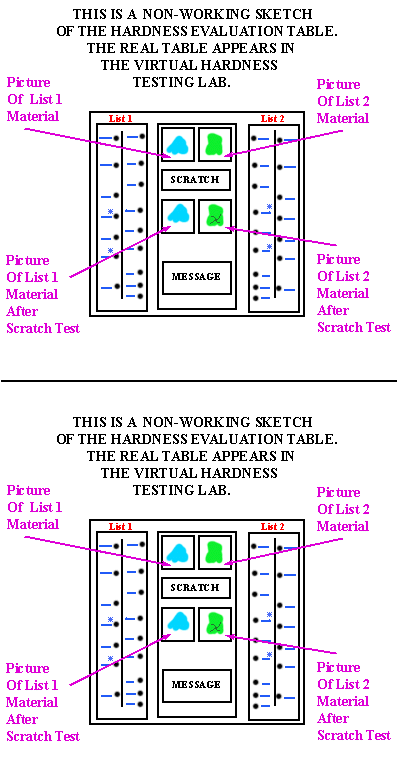- After you have read these instructions (1 through 5), you will go to the Virtual Hardness Testing Lab. There you will see the Hardness Evaluation Table.
- HOW THE TABLE WORKS: A SKETCH (not the real thing) of the Table is shown on the right. The Table has two identical lists of mineral specimens and testing tools: one on the left (List 1) and one on the right (List 2). The Mohs mineral specimens are marked with asterisks *.
- On the real Table, you will click on the buttons to choose a different Mohs mineral from each list. Pictures of the two Mohs minerals will appear in the top two boxes.
- Then you will press the "SCRATCH" button. Pictures of the same two Mohs mineral specimens will appear in the lower two boxes. The softer of the two Mohs minerals will have a scratch on it. A message will appear in the message box.
- Get 10 small index cards or pieces of paper and set them out in a row. On each, write the specimen number of one of the ten Mohs minerals (indicated by asterisks).
- Now, test each Mohs minerals against each of the other Mohs minerals to determine their relative hardnesses. As you decide which is harder than which, keep rearranging the pieces of paper so that the softest mineral is on the left and the hardest is on the right.
- When you have tested them all, list the specimen numbers of the ten Mohs minerals in order of their hardness on a peice of paper. Give each specimen a hardness number, from H = 1 to H = 10, with H = 1 being the softest, and H = 10 being the hardest. For example:
Specimen # 23, H = 1;
Specimen # 12, H = 2; etc.
You have now made a Mohs Hardness Scale!
- After you have constructed your Mohs Hardness Scale, return to this page. Enter your results in the 'interactive' Answer Checking Table (see the purple button below) to see if they are correct. Once they are correct, enter them in Part B of the HARDNESS EXERCISES WORK SHEET (MN-3).
NOW THAT YOU'VE READ THE INSTRUCTIONS, CLICK ON THE GREY BAR BELOW AND....
 | Go to the Answer Checking Table |
|
 |


